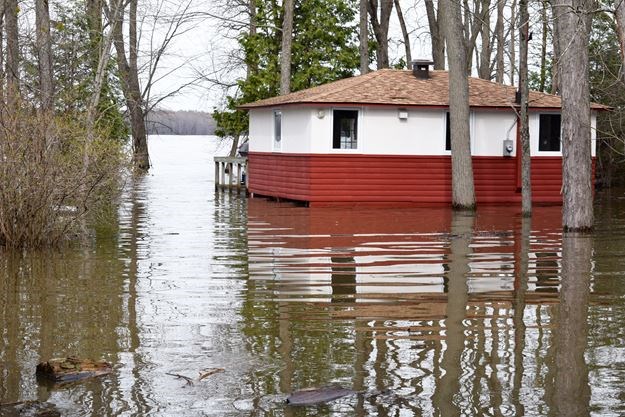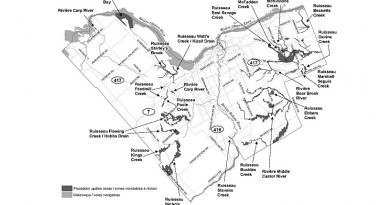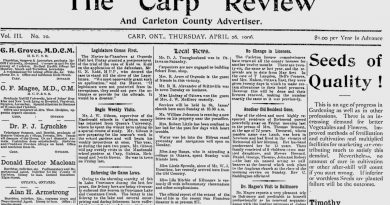ORRPB says ‘flood-prone areas at risk’
Special to WC Online
WEST CARLETON — The Ottawa River Regulation Planning Board (ORRPB) is expecting major flood levels to be ‘exceeded over the weekend’ the board released in a statement today (April 18).
“The Ottawa River Regulating Committee warns levels and flows on the Ottawa River, from Lac Coulonge down to the Montreal region, are expected to rise extremely rapidly starting this Friday due to forecast rainfall and snowmelt runoff,” the ORRPB said.
“Major flood levels are expected to be exceeded over the weekend. Later on, flows and levels similar to those observed at the height of the May 2017 flood may be reached depending on the amount of precipitation received. All flood-prone areas along the Ottawa River from Lac Coulonge down to the Montreal Archipelago are at risk.”
Two low pressure systems are expected to bring 30 to 80 millimetres of precipitation over much of the basin from Thursday through to Saturday. At the same time, warmer temperatures will melt a large portion of the remaining snowpack in the central areas of the basin.
“Rainfall and snowmelt will combine to produce very high runoff, causing levels to rise sharply on the Ottawa River starting this Friday,” the ORRPB said. |Levels are expected to exceed major flood levels, which are the levels at which several houses are impacted, over the weekend in flood-prone areas along the Ottawa River.”
Levels as high as those seen in May 2017, at the height of the flood, could be reached depending on the amount of precipitation received.
“Due to the forecast uncertainty it is difficult to accurately predict how quickly water levels will rise and when river conditions may peak,” the ORRPB said. “Residents of flood-prone areas are encouraged to closely follow evolving conditions and to take necessary measures.”
The committee will be reassessing forecast conditions and providing hydrological condition updates on its website daily. Reservoir Regulation Strategy:
The ORRPB will enact its Reservoir Regulation Strategy to try to mitigate the flooding.
“The principal storage reservoirs in the northern part of the watershed are expected to contain the majority of the increased runoff in those areas,” the ORRPB said. “However, dams located in the central and southern portions of the basin are essentially ‘run of the river’ with no significant storage capacity.
“As such, they cannot significantly reduce the flows and levels associated with increased spring runoff. During this critical freshet period, the regulating committee will take all possible actions to limit the amount of flooding and will continuously monitor conditions at all points along the river.”
If you think your property may be at risk of flooding, please contact your municipality. The Ottawa River Regulating Committee works closely at all times with provincial agencies responsible for issuing flood related messages.
In Ontario, Conservation Authorities and District Offices of the Ministry of Natural Resources and Forestry issue flood related messages and information to municipalities and other key agencies involved in flood preparedness and response. Current flood related messages can be viewed on-line on the individual conservation authority websites and on the provincial flood webpage.
The Canadian Red Cross has several suggestions for preparing for a flood and the aftermath:
Before a flood:
- Monitor local weather and alerts: Know your risk.
- Turn around, don’t drown – avoid flood waters.
- Clean up carefully and wear protective clothing.
- The key to staying safe is to prepare and to have an emergency plan in place.
- Know the flood risk in your community by calling your municipality and insurance company.
- Know and practice evacuation routes.
- Monitor local weather and alerts and follow instructions if told to evacuate.
Actions to take:
- Protect your valuables in waterproof containers. Place them above potential water levels.
- Put sealant around basement windows and the base of ground-level doors.
- Raise large appliances in the basement above the potential water level from a flood.
- Make sure your sump pump is working and install a battery-operated backup.
- Check that your roof and eavestroughs are draining properly in heavy rains.
- Talk with your family and neighbours about what you would do during a flood.
- Have practice drills with your family, so you know what to do and are prepared.
During a flood:
- Listen to area radio and television stations and Weatheradio for possible flood warnings and reports of flooding in progress.
- Be prepared to evacuate at a moment’s notice.
- When a flood or flash flood warning is issued for your area, head for higher ground and stay there.
- Turn around – don’t drown! Avoid walking and driving through flooded waters. They could be deeper than you think.
- Keep children and pets away from flood water.
- Be especially cautious at night when it is harder to recognize flood danger.
After a flood:
Consult the Canadian Red Cross Guide To Flood Recovery for step-by-step instructions. Continue to take precautions and listen to and follow directions from local authorities.
- Be alert for further instructions from officials and community leaders – listen to the radio, watch your local news channels, and/or follow your local news outlet and/or emergency officials on social media.
- Do not return home until you are advised it is safe to do so.
- Contact your insurance company and let them know what happened. They will want to know a record of damage to your home and belongings and may request photos or video.
- Maintain good hygiene during flood cleanup by minimizing contact with floodwater or anything that may have come in contact with it.
- Wear protective clothing, including rubber boots or sturdy boots, safety glasses, hard hat, rubber gloves and a dust mask.
- Do not use water that could be contaminated.
- Discard any food items which may have been in contact with flood waters. When in doubt, throw it out!
- Do not use any appliances, heating, pressure, or sewage system until electrical components are dry and have been inspected by a qualified electrician.
- Check with local authorities or community leaders on how to properly dispose of damaged items from your home.
Learn more: Floods: Information & Facts.
West Carleton Disaster Relief also has a comprehensive flood information page.













